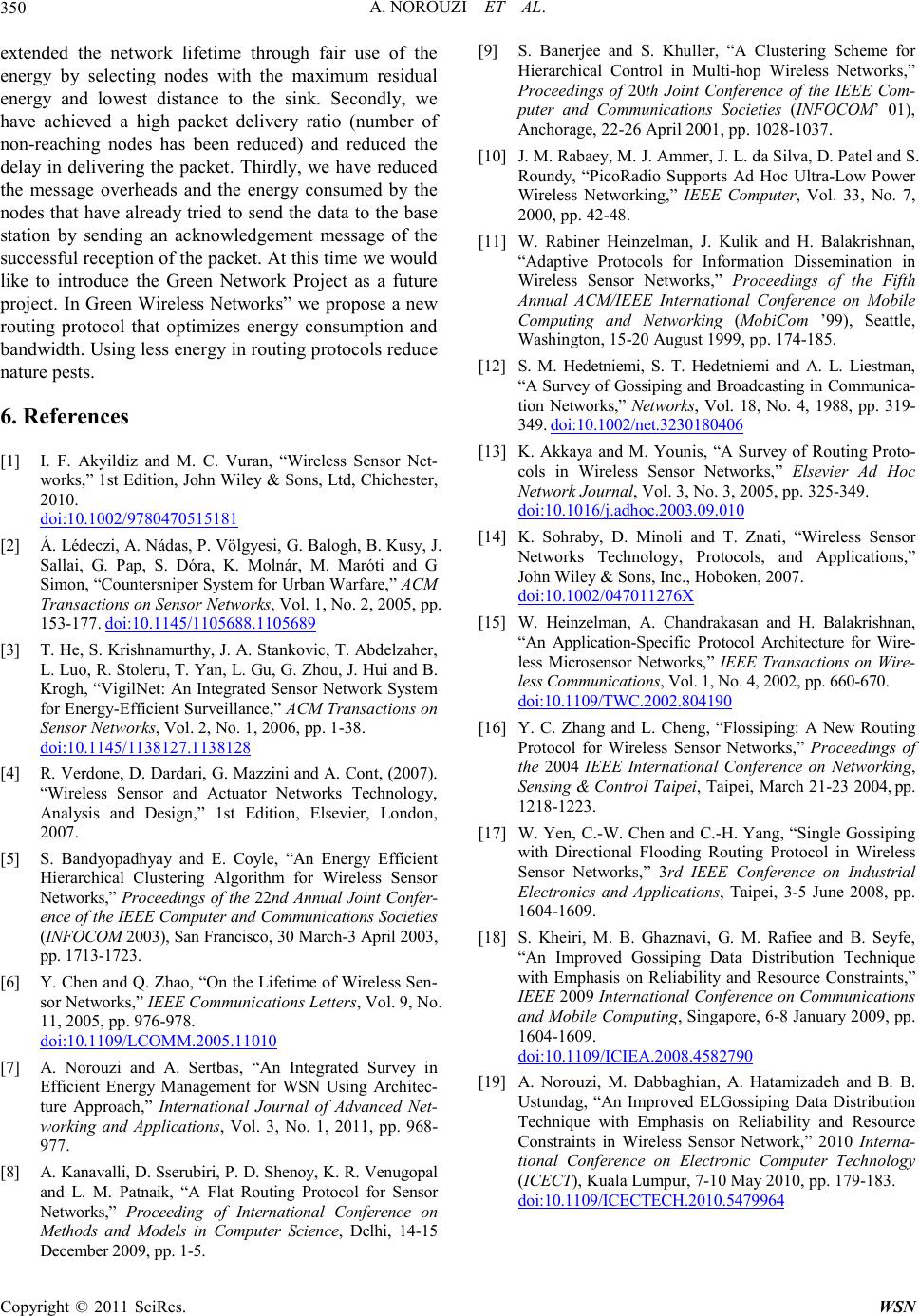
A. NOROUZI ET AL.
Copyright © 2011 SciRes. WSN
350
extended the network lifetime through fair use of the
energy by selecting nodes with the maximum residual
energy and lowest distance to the sink. Secondly, we
have achieved a high packet delivery ratio (number of
non-reaching nodes has been reduced) and reduced the
delay in delivering the packet. Thirdly, we have reduced
the message overheads and the energy consumed by the
nodes that have already tried to send the data to the base
station by sending an acknowledgement message of the
successful reception of the packet. At this time we would
like to introduce the Green Network Project as a future
project. In Green Wireless Networks” we propose a new
routing protocol that optimizes energy consumption and
bandwidth. Using less energy in routing protocols reduce
nature pests.
6. References
[1] I. F. Akyildiz and M. C. Vuran, “Wireless Sensor Net-
wor ks ,” 1st Edition, John Wiley & Sons, Ltd, Chichester,
2010.
doi:10.1002/9780470515181
[2] Á. Léd ec zi , A. N ád as , P . V öl gye s i, G. B al o gh , B. Ku sy, J.
Sallai, G. Pap, S. Dóra, K. Molnár, M. Maróti and G
Simon, “Countersniper System for Urban Warfare,” ACM
Transactions on Sensor Networks, Vol. 1, No. 2, 2005, pp.
153-177. doi:10.1145/1105688.1105689
[3] T. He, S. Krishnamurthy, J. A. St ankovic, T. Abdel zaher,
L. Luo, R. Stoleru, T. Yan, L. Gu, G. Zhou, J. Hui and B.
Krogh, “VigilNet: An Integrated Sensor Network System
for Energy-Efficient Surveillance,” ACM Transactions on
Sensor Networks, Vol. 2, N o. 1, 2 0 06 , pp. 1-38.
doi:10.1145/1138127.1138128
[4] R. Verdone, D. Dard ari, G. Mazzini and A. Cont , (2007).
“Wireless Sensor and Actuator Networks Technology,
Analysis and Design,” 1st Edition, Elsevier, London,
2007.
[5] S. Bandyopadhyay and E. Coyle, “An Energy Efficient
Hierarchical Clustering Algorithm for Wireless Sensor
Networks,” Proceedings of the 22nd Annual Joint Confer-
ence of the IEEE Computer and Communications Societies
(INFOCOM 2003), San Francisco, 30 March-3 April 2003,
pp. 1713-1 723.
[6] Y. Chen and Q. Zhao, “On the Lifetime of Wireless Sen-
sor Networks,” IEEE Communications Letters, Vol. 9, No.
11, 2005, pp. 97 6- 9 78 .
do i:10.1109/LCOM M.2005.11010
[7] A. Norouzi and A. Sertbas, “An Integrated Survey in
Efficient Energy Management for WSN Using Architec-
ture Approach,” International Journal of Advanced Net-
working and Applications, Vol. 3, No. 1, 2011, pp. 968-
977.
[8] A. Kanavalli, D. Sserubiri, P. D. Shenoy, K. R. Venugopal
and L. M. Patnaik, “A Flat Routing Protocol for Sensor
Networks,” Proceeding of International Conference on
Methods and Models in Computer Science, Delhi, 14-15
December 2009, pp. 1-5 .
[9] S. Banerjee and S. Khuller, “A Clustering Scheme for
Hierarchical Control in Multi-hop Wireless Networks,”
Proceedings of 20th Joint Conference of the IEEE Com-
puter and Communications Societies (INFOCOM’ 01),
Anchorage, 22-26 April 2001, pp. 1028-1037.
[10] J. M. Rabaey, M. J. Ammer, J. L. da Silva, D. Patel and S.
Roundy, “PicoRadio Supports Ad Hoc Ultra-Low Power
Wireless Networking,” IEEE Computer, Vol. 33, No. 7,
2000, pp. 42- 4 8.
[11] W. Rabiner Heinzelman, J. Kulik and H. Balakrishnan,
“Adaptive Protocols for Information Dissemination in
Wireless Sensor Networks,” Proceedings of the Fifth
Annual ACM/IEEE International Conference on Mobile
Computing and Networking (MobiCom ’99), Seattle,
Was hing ton, 15-20 Aug us t 199 9, pp. 17 4-185.
[12] S. M. Hedetniemi, S. T. Hedetniemi and A. L. Liestman,
“A Survey of Gossiping and Broadcasting in Communica-
tion Networks,” Networks, Vol. 18, No. 4, 1988, pp. 319-
349. doi:10.1002/net.3230180406
[13] K. Akkaya and M. Younis, “A Survey of Routing Proto-
cols in Wireless Sensor Networks,” Elsevier Ad Hoc
Network Journal, Vol. 3, N o. 3, 2 005, pp. 325- 3 49.
do i:10.1016/j.adhoc.2003.09 .010
[14] K. Sohraby, D. Minoli and T. Znati, “Wireless Sensor
Networks Technology, Protocols, and Applications,”
John Wiley & Sons, Inc., Hoboken, 2007.
doi:10.1002/047011276X
[15] W. Heinzelman, A. Chandrakasan and H. Balakrishnan,
“An Application-Specific Protocol Architecture for Wire-
less Microsensor Networks,” IEEE Transactions on Wire-
less C omm unications , Vol. 1, No. 4, 200 2, p p. 66 0- 67 0.
doi:10.1109/TWC.2002.804190
[16] Y. C. Zhang and L. Cheng, “Flossiping: A New Routing
Protocol for Wireless Sensor Networks,” Proceedings of
the 2004 IEEE International Conference on Networking,
Sensing & Control Taipei, Taipei, March 21-23 2004, pp.
1218-1223.
[17] W. Yen, C.-W. Chen and C.-H. Yang, “Single Gossiping
with Directional Flooding Routing Protocol in Wireless
Sensor Networks,” 3rd IEEE Conference on Industrial
Electronics and Applications, Taipei, 3-5 June 2008, pp.
1604-1609.
[18] S. Kheiri, M. B. Ghaznavi, G. M. Rafiee and B. Seyfe,
“An Improved Gossiping Data Distribution Technique
with Emphasis on Reliability and Resource Constraints,”
IEEE 2009 International Conference on Communications
and Mobile Computing, Singapore, 6-8 January 2009, pp.
1604-1609.
doi:10.1109/ICIEA.2008.4582790
[19] A. Norouzi, M. Dabbaghian, A. Hatamizadeh and B. B.
Ustundag, “An Improved ELGossiping Data Distribution
Technique with Emphasis on Reliability and Resource
Constraints in Wireless Sensor Network,” 2010 Interna-
tional Conference on Electronic Computer Technology
(ICECT), Kuala Lumpur, 7-10 May 2010, pp. 179-183.
doi:10.1109/ICECTECH.2010.5479964